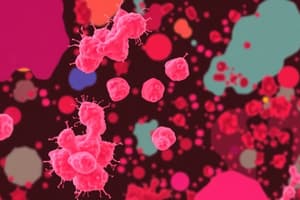Podcast
Questions and Answers
What is the main shape of Staphylococcus bacteria?
What is the main shape of Staphylococcus bacteria?
- Spherical-shaped (correct)
- Rod-shaped
- Square-shaped
- Spiral-shaped
Staphylococcus epidermis is a coagulase-positive bacterium.
Staphylococcus epidermis is a coagulase-positive bacterium.
False (B)
Name one disease caused by Staphylococcus aureus.
Name one disease caused by Staphylococcus aureus.
soft tissue infections
Staphylococcus aureus produces __________, which helps it evade the immune system by causing plasma clots.
Staphylococcus aureus produces __________, which helps it evade the immune system by causing plasma clots.
Match the following Staphylococcus aureus virulence factors with their functions:
Match the following Staphylococcus aureus virulence factors with their functions:
Which of the following is a characteristic of Methicillin-resistant Staphylococcus aureus (MRSA)?
Which of the following is a characteristic of Methicillin-resistant Staphylococcus aureus (MRSA)?
Staphylococcus aureus can lead to toxic shock syndrome through the creation of biofilms on tampons.
Staphylococcus aureus can lead to toxic shock syndrome through the creation of biofilms on tampons.
What is the primary method that Staphylococcus uses to attach to host tissues?
What is the primary method that Staphylococcus uses to attach to host tissues?
The __________ toxin can cause severe diarrhea by damaging the cell membrane of intestinal cells.
The __________ toxin can cause severe diarrhea by damaging the cell membrane of intestinal cells.
Which virulence factor allows Staphylococcus aureus to break down fat for colonization on oily skin?
Which virulence factor allows Staphylococcus aureus to break down fat for colonization on oily skin?
What was the target reduction rate for MRSA septicaemia set by the NHS in 2004?
What was the target reduction rate for MRSA septicaemia set by the NHS in 2004?
The mecA gene makes bacteria more susceptible to beta-lactam antibiotics.
The mecA gene makes bacteria more susceptible to beta-lactam antibiotics.
What is the primary purpose of the coagulase test?
What is the primary purpose of the coagulase test?
Staphylococcus epidermidis is known to have _______ haemolysis on blood agar.
Staphylococcus epidermidis is known to have _______ haemolysis on blood agar.
Match the following Staphylococcus species with their characteristics:
Match the following Staphylococcus species with their characteristics:
Which of the following tests is commonly used to detect the presence of mecA gene in MRSA strains?
Which of the following tests is commonly used to detect the presence of mecA gene in MRSA strains?
S. epidermidis is primarily associated with foodborne infections.
S. epidermidis is primarily associated with foodborne infections.
What does the term 'differential diagnosis' refer to in the context of bacterial infections?
What does the term 'differential diagnosis' refer to in the context of bacterial infections?
Antibiotics such as _______ and _______ are commonly used to treat MRSA infections.
Antibiotics such as _______ and _______ are commonly used to treat MRSA infections.
What characteristic distinguishes S. aureus from S. epidermidis?
What characteristic distinguishes S. aureus from S. epidermidis?
What type of hemolysis is associated with Streptococcus pyogenes?
What type of hemolysis is associated with Streptococcus pyogenes?
Streptococcus pneumoniae is classified under Lancefield groupings.
Streptococcus pneumoniae is classified under Lancefield groupings.
What is the primary virulence factor associated with Streptococcus pyogenes that has anti-phagocytic properties?
What is the primary virulence factor associated with Streptococcus pyogenes that has anti-phagocytic properties?
Streptococcus pyogenes can break down ______, allowing it to spread through host tissues.
Streptococcus pyogenes can break down ______, allowing it to spread through host tissues.
Match the following virulence factors with their functions:
Match the following virulence factors with their functions:
Which antibiotic is NOT commonly used to treat infections caused by Streptococcus pyogenes?
Which antibiotic is NOT commonly used to treat infections caused by Streptococcus pyogenes?
Lysogenic bacteriophages are not present in strains of Streptococcus pyogenes.
Lysogenic bacteriophages are not present in strains of Streptococcus pyogenes.
Infections caused by Streptococcus pyogenes can lead to acute ________, which may follow a throat infection.
Infections caused by Streptococcus pyogenes can lead to acute ________, which may follow a throat infection.
What type of agar is used to differentiate Streptococcus species based on their hemolytic properties?
What type of agar is used to differentiate Streptococcus species based on their hemolytic properties?
Which of the following methods is used for rapid identification of Streptococcus pyogenes?
Which of the following methods is used for rapid identification of Streptococcus pyogenes?
Flashcards
How to differentiate between S.aureus and S.epidermis
How to differentiate between S.aureus and S.epidermis
S.aureus produces catalase and coagulase, while S.epidermis is coagulase negative.
What is the function of Hyaluronidase?
What is the function of Hyaluronidase?
Breakdown of hyaluronic acid, a component of the extracellular matrix, allowing the bacteria to spread within animal tissues.
What diseases can Staphylococcus aureus cause?
What diseases can Staphylococcus aureus cause?
Staphylococcus aureus can cause various infections, including skin infections (impetigo), Toxic Shock Syndrome (TSS), septicaemia, and osteomyelitis.
How does Staphlokinase facilitate the spread of S.aureus?
How does Staphlokinase facilitate the spread of S.aureus?
Signup and view all the flashcards
What are the key characteristics of Enterotoxins?
What are the key characteristics of Enterotoxins?
Signup and view all the flashcards
What is the effect of Exfoliatin toxin?
What is the effect of Exfoliatin toxin?
Signup and view all the flashcards
How does Coagulase help S.aureus evade the immune system?
How does Coagulase help S.aureus evade the immune system?
Signup and view all the flashcards
How does S.aureus evade immune recognition?
How does S.aureus evade immune recognition?
Signup and view all the flashcards
How does Protein A interfere with immune responses?
How does Protein A interfere with immune responses?
Signup and view all the flashcards
What is MRSA?
What is MRSA?
Signup and view all the flashcards
Horizontal Gene Transfer (HGT)
Horizontal Gene Transfer (HGT)
Signup and view all the flashcards
mecA Gene
mecA Gene
Signup and view all the flashcards
Beta-Lactamase
Beta-Lactamase
Signup and view all the flashcards
Mannitol Salt Agar (MSA)
Mannitol Salt Agar (MSA)
Signup and view all the flashcards
Catalase Test
Catalase Test
Signup and view all the flashcards
Coagulase Test
Coagulase Test
Signup and view all the flashcards
Nucleic Acid Amplification Tests (NAAT)
Nucleic Acid Amplification Tests (NAAT)
Signup and view all the flashcards
Pulsed-Field Gel Electrophoresis (PFGE)
Pulsed-Field Gel Electrophoresis (PFGE)
Signup and view all the flashcards
Multilocus Sequence Typing (MLST)
Multilocus Sequence Typing (MLST)
Signup and view all the flashcards
Matrix-Assisted Laser Desorption/Ionization Time-of-Flight Mass Spectrometry (MALDI-TOF MS)
Matrix-Assisted Laser Desorption/Ionization Time-of-Flight Mass Spectrometry (MALDI-TOF MS)
Signup and view all the flashcards
Lancefield Grouping Test
Lancefield Grouping Test
Signup and view all the flashcards
Streptococcus pyogenes (Group A)
Streptococcus pyogenes (Group A)
Signup and view all the flashcards
M-protein
M-protein
Signup and view all the flashcards
Hyaluronidase
Hyaluronidase
Signup and view all the flashcards
Streptolysin O
Streptolysin O
Signup and view all the flashcards
Pyrogenic Exotoxins of S. pyogenes
Pyrogenic Exotoxins of S. pyogenes
Signup and view all the flashcards
Lysogeny
Lysogeny
Signup and view all the flashcards
Hyaluronic capsule
Hyaluronic capsule
Signup and view all the flashcards
Bacitracin test
Bacitracin test
Signup and view all the flashcards
Nucleic Acid Amplification Tests
Nucleic Acid Amplification Tests
Signup and view all the flashcards
Study Notes
Staphylococci Overview
- Staphylococci are Gram-positive cocci that grow in clusters.
- Common species include Staphylococcus aureus and some Staphylococcus epidermis.
- S. aureus is catalase and coagulase-positive, while S. epidermis is coagulase-negative.
- Found as commensals in the human body (nose, groin, colon).
- Can cause a range of infections, including soft tissue infections, impetigo, toxic shock syndrome (TSS), septicemia, and osteomyelitis.
Virulence Factors of Staphylococci
-
Enzymes:
- Coagulase: Forms blood clots, protecting bacteria from immune cells.
- Hyaluronidase: Breaks down hyaluronic acid, allowing bacteria to spread.
- Deoxyribonuclease (DNase): Degrades DNA, facilitating biofilm formation and spread.
- Lipase: Digests lipids, aiding colonization of oily skin.
- Beta-lactamases (penicillinase): Degrades penicillin, contributing to antibiotic resistance.
- Staphylokinase: Dissolves fibrin clots, facilitating bacterial spread.
-
Toxins:
- Enterotoxins: Cause food poisoning, various serotypes (Alpha, Beta, Delta).
- Alpha toxin (SEA): Pore-forming, damages cell membranes.
- Beta toxin (SEB): Damages membranes, targeting macrophages.
- Delta toxin (SED): Cytopathic, targets macrophages, causes cell death.
- Superantigens (eg Toxic Shock Syndrome Toxin-1): Trigger massive immune responses, leading to septic shock.
- Exfoliatin toxins (ETA, ETB): Cause scalded skin syndrome, separating epidermis layers.
- Exotoxins (eg leukocidin): Target white blood cells.
- Enterotoxins: Cause food poisoning, various serotypes (Alpha, Beta, Delta).
-
Immuno-evasive strategies:
- Polysaccharide capsule (glycocalyx): Hides antigens, making bacteria less recognizable to the immune system.
- Surface proteins:
- Protein A: Disrupts opsonization and phagocytosis, preventing immune cells from engulfing bacteria.
- Adhesins: Bind to host tissues, promoting bacterial attachment.
- Clumping factors: Bind to fibrin/fibrinogen, contributing to bacterial aggregation and dissemination.
Methicillin-Resistant Staphylococcus aureus (MRSA)
- Emerged in the 1981.
- Significant increase in infections and mortality rates.
- Prevention and control measures have been implemented to reduce infections(mandatory surveillance, reduction targets, legal framework).
- Resistance is due to the mecA gene, acquired through horizontal gene transfer.
- mecA encodes a penicillin-binding protein 2a (PBP2a), which reduces affinity for beta-lactam antibiotics like methicillin and penicillin.
- Other resistance mechanisms may exist, including production of beta-lactamases.
- Diagnosis is required for appropriate treatments and preventing overuse of antibiotics.
Laboratory Diagnosis of Staphylococci
- Gram staining: Shows Gram-positive cocci in clusters.
- Colony Morphology: S. aureus often forms yellow colonies.
- Biochemical tests: Catalase and coagulase tests, as well as mannitol fermentation.
- Haemolysis: On blood agar, some strains cause haemolysis (beta or alpha).
- Molecular tests: PCR, MALDI-TOF MS, PFGE, and MLST for strain identification and antibiotic resistance determination.
Treatment of Staphylococcal Infections
- Decolonisation: Removal of bacteria from affected areas through cleaning and antibiotics.
- Antibiotics: Options vary based on the infection and antibiotic resistance (flucloxacillin, dicloxacillin, cephalosporins, clindamycin, vancomycin) and combinations of antibiotics.
Streptococcus Overview
- Streptococci are Gram-positive cocci in chains.
- Facultative anaerobes, oxidase-negative, catalase-negative, and fermentative bacteria.
- Distinguished by Lancefield groupings (based on surface carbohydrates).
- Common groups associated with human disease include A, B, C, D, and G.
Virulence Factors of Streptococci (S. pyogenes)
- Enzymes:
- C5a peptidase: Inhibits complement activation.
- Hyaluronidase: Breaks down hyaluronic acid, promotes bacterial spread.
- Nucleases: Degrade DNA, promote bacterial spread
- Proteinases and Streptokinases: Degrade soft tissue and fibrin clots.
- Toxins:
- Streptolysin O: Oxygen-labile cytolysin (haemolytic).
- Streptolysin S: Oxygen-stable cytolysin, less immunogenic.
- Pyrogenic exotoxins: Superantigens causing fever and rash (scarlet fever).
- Immunoevasion:
- Hyaluronic capsule: Mimics host tissue, preventing immune recognition.
- Surface proteins (M protein, Lipoteichoic acids): Inhibit phagocytosis and complement activation.
Laboratory Diagnosis of Streptococci
- Gram staining: Shows Gram-positive cocci in chains.
- Colony morphology: may show mucoid colonies.
- Haemolysis: On blood agar (beta, alpha, gamma) to differentiate strains.
- Biochemical tests: Catalase, Bacitracin sensitivity
- Molecular tests: PCR to identify specific strains or genes.
Treatment of Streptococcal Infections
- Antibiotics: Penicillin, amoxicillin, erythromycin to treat, with consideration of antibiotic resistance profiles.
- Vaccines: Available for some streptococcal strains like S. pneumoniae.
Studying That Suits You
Use AI to generate personalized quizzes and flashcards to suit your learning preferences.





